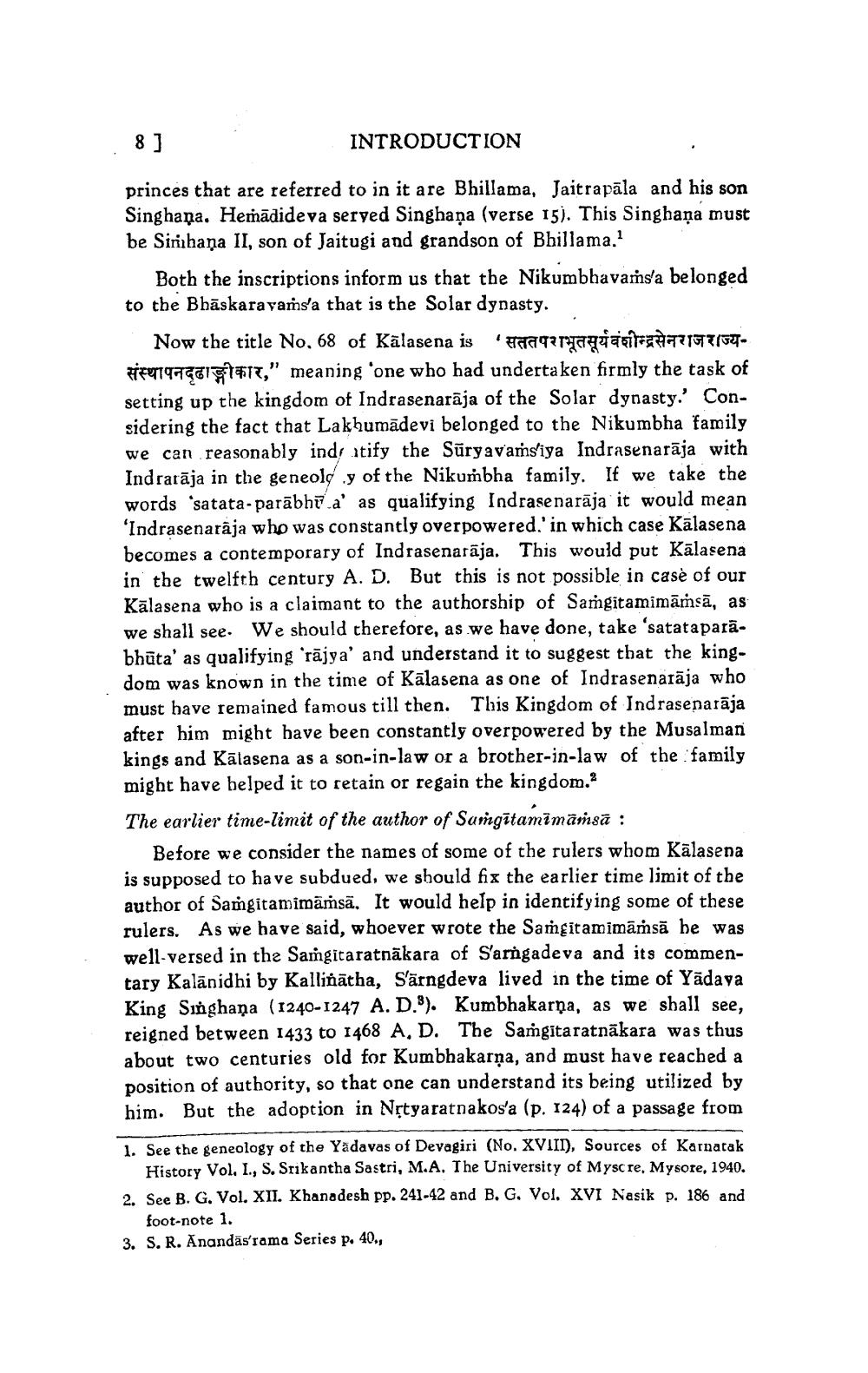________________
.
8 ]
INTRODUCTION
princes that are referred to in it are Bhillama, Jaitrapāla and his son Singhaņa. Hemādideva seryed Singhaņa (verse 15). This Singhaņa must be Sirishaņa II, son of Jaitugi and grandson of Bhillama.?
Both the inscriptions inform us that the Nikumbhavamsa belonged to the Bhāskarayamsa that is the Solar dynasty.
Now the title No. 68 of Kālasena is reqatagjasitta71777154FFETT9796151817," meaning 'one who had undertaken firmly the task of setting up the kingdom of Indrasenarāja of the Solar dynasty.' Considering the fact that Lakhumādevi belonged to the Nikumbha family we can reasonably indratify the Süryavass'iya Indrasenarāja with Indrarāja in the geneolo y of the Nikumbha family. If we take the words 'satata- parābhū a' as qualifying Indrasenarāja it would mean 'Indrasenaraja who was constantly overpowered.' in which case Kālasena becomes a contemporary of Indrasenarāja. This would put Kālasena in the twelfth century A. D. But this is not possible in case of our Kālasena who is a claimant to the authorship of Sargitamimāṁsā, as we shall see. We should therefore, as we have done, take 'satataparābhūta' as qualifying 'rājya' and understand it to suggest that the king. dom was known in the time of Kālasena as one of Indrasenarāja who must have remained famous till then. This Kingdom of Indrasenarāja after him might have been constantly overpowered by the Musalman kings and Kālasena as a son-in-law or a brother-in-law of the family might have belped it to retain or regain the kingdom.
The earlier time-limit of the author of Samgitamimamsā :
Before we consider the names of some of the rulers whom Kālasena is supposed to have subdued, we should fix the earlier time limit of the author of Samgitamimāṁsā. It would help in identifying some of these rulers. As we have said, whoever wrote the Samgitamimāṁsā he was well-versed in the Samgitaratnākara of Sarngadeva and its commentary Kalanidhi by Kalliñātha, Sārngdeva lived in the time of Yadaya King Singhana (1240-1247 A. D.%). Kumbhakarņa, as we shall see. reigned between 1433 to 1468 A, D. The Samgitaratnākara was thus about two centuries old for Kumbhakarņa, and must have reached a position of authority, so that one can understand its being utilized by him. But the adoption in Nętyaratnakos'a (p. 124) of a passage from
1. See the geneology of the Yadavas of Devagiri (No. XVIII), Sources of Karnatak
History Vol, I., S. Srikantha Sastri, M.A. The University of Mysc re, Mysore, 1940. 2. See B. G. Vol. XII. Khanadesh pp. 241-42 and B. G. Vol. XVI Nasik p. 186 and
foot-note 1. 3. S. R. Anandās'rama Series p. 40.,




